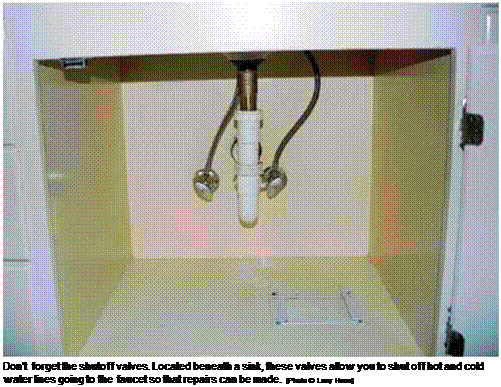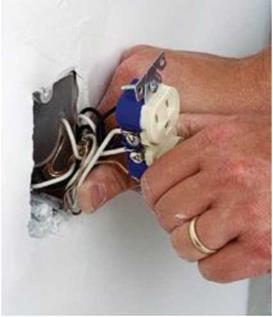STEP 3 GET TO KNOW ELECTRICAL AND MECHANICAL SYSTEMS
|
|
a mechanic take care of this routine maintenance, but it can quickly get expensive—and besides, it’s satisfying to understand the basics of your daily transportation. The same goes for a house. There’s no need to call a plumber every time you have a leaky faucet or an electrician every time a circuit breaker needs to be reset. Now that you’ve finished building an affordable house, you can maintain it affordably with a little basic know-how.
For safety’s sake, one of the first things you should check is that all switch, outlet, doorbell, and exhaust fan covers are securely in place.

 As a homeowner, you should also know the location of the main electrical circuit box. It contains wires leading to every part of the house and the circuit breakers, which are the switches that control the electricity on individual circuits. Open the box door covering the circuit breakers and make sure the electrical contractor has labeled what each breaker controls. This circuit map should be on the inside of the door. You should be able to identify the separate breakers for the stove, refrigerator, and furnace, as well as lighting and receptacle circuits for different parts of the house. There will also be a large single breaker that completely shuts down the current throughout the house. With well – labeled breakers, you’ll be able to shut off power when you need to do wiring work on a specific switch or outlet.
As a homeowner, you should also know the location of the main electrical circuit box. It contains wires leading to every part of the house and the circuit breakers, which are the switches that control the electricity on individual circuits. Open the box door covering the circuit breakers and make sure the electrical contractor has labeled what each breaker controls. This circuit map should be on the inside of the door. You should be able to identify the separate breakers for the stove, refrigerator, and furnace, as well as lighting and receptacle circuits for different parts of the house. There will also be a large single breaker that completely shuts down the current throughout the house. With well – labeled breakers, you’ll be able to shut off power when you need to do wiring work on a specific switch or outlet.

 If an outlet doesn’t work, one of the first things to check is whether it’s a ground-fault circuit interrupter (GFCI) outlet. GFCI protection is required for outdoor receptacles (outlets) and electrical outlets in the kitchen and bathroom—places where the presence of moisture might pose an electrical shock hazard. If overloading or an electrical short is detected, a GFCI circuit breaker will shut down at the main service panel, cutting off power to all outlets on the circuit. GFCI protection can also be provided by a GFCI receptacle that’s wired to other receptacles. Both GFCI devices have test and reset buttons. Find out which type of GFCI protection you have, where the devices are located, and which outlets they control.
If an outlet doesn’t work, one of the first things to check is whether it’s a ground-fault circuit interrupter (GFCI) outlet. GFCI protection is required for outdoor receptacles (outlets) and electrical outlets in the kitchen and bathroom—places where the presence of moisture might pose an electrical shock hazard. If overloading or an electrical short is detected, a GFCI circuit breaker will shut down at the main service panel, cutting off power to all outlets on the circuit. GFCI protection can also be provided by a GFCI receptacle that’s wired to other receptacles. Both GFCI devices have test and reset buttons. Find out which type of GFCI protection you have, where the devices are located, and which outlets they control.
By pressing the test and reset buttons, you’ll see how they work.
Many electrical codes also protect houses using AFCIs (arc-fault circuit interrupters). Fires sometimes start when electricity arcs between two points. If an arc occurs, an AFCI automatically cuts off the flow of electricity. Power can be restored by resetting the breaker in the main control box in the house once the problem has been fixed.
In the same way that there’s a main electrical shutoff switch in the electrical circuit box, there are also shutoff valves for the water and, in some places, the natural gas supplies that come into a home. Find out from your plumber and heating contractor where these valves are, and label them clearly. Water and gas lines can break, and being able to shut off the flow of water or gas could mean the difference between a minor problem and a catastrophe.
Turning a valve on the gas meter with a crescent wrench can often shut it off. There is a shutoff valve on the main water pipe coming into the house. There are also localized shutoff valves under sinks and toilets and near washer-dryer units (see the photo at left). These allow you to turn off the water to a particular appliance so that you can fix a dripping faucet or make other repairs.
Be familiar with heating and airconditioning components
The filter is an inexpensive but very important part of most forced-air heating systems. A central air-conditioning system also relies on a filter to trap dust and dirt that may otherwise be blown into living spaces when the system is operating. Make sure you know where these filters are located and how to change them. Replacing a furnace or central AC filter usually takes no more than a minute or two. Always have one or two new replacement filters on hand. Check your working filter against a new one, and replace the old filter once it’s discolored by trapped material. A well-functioning filter is good for your health and the health of your HVAC system.







Leave a reply